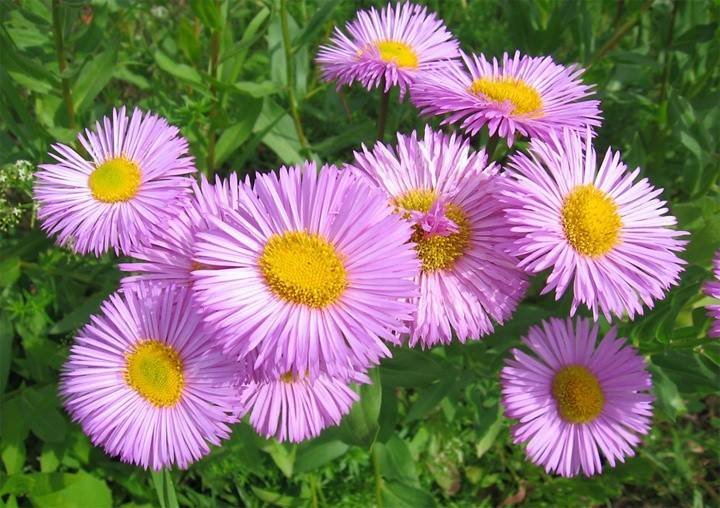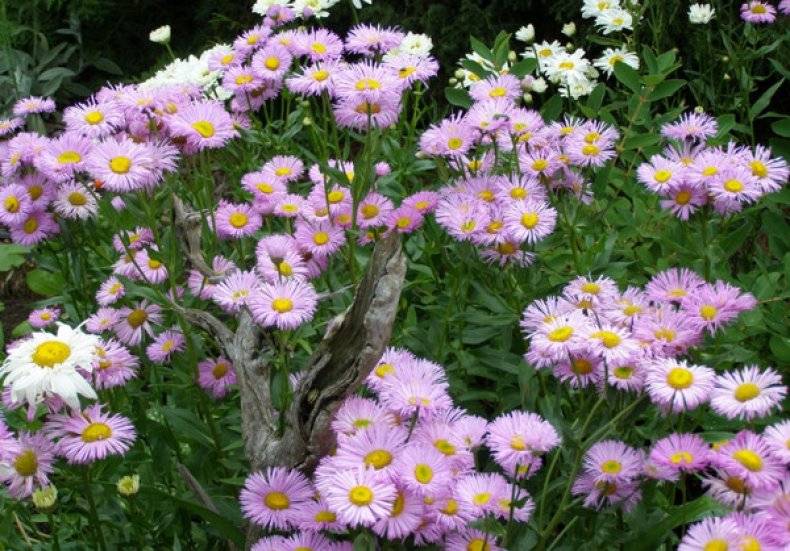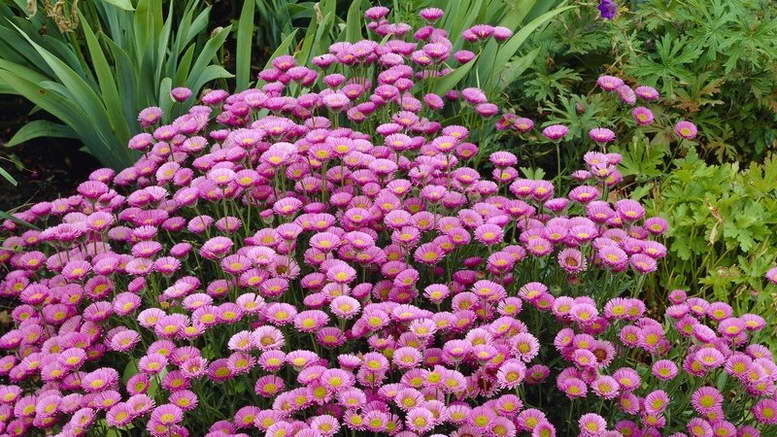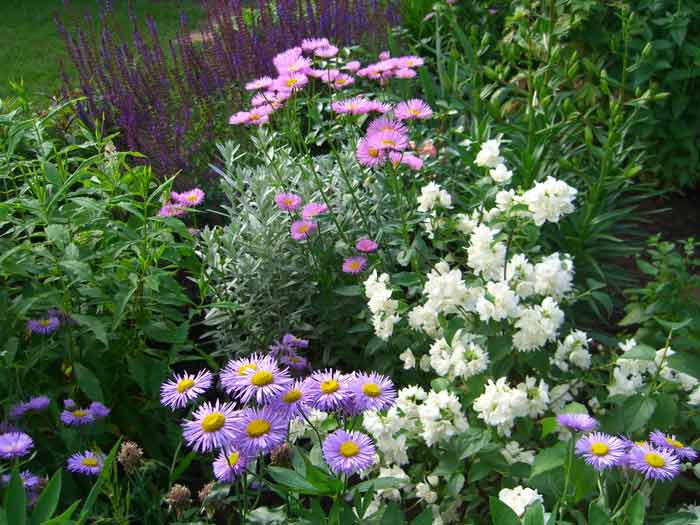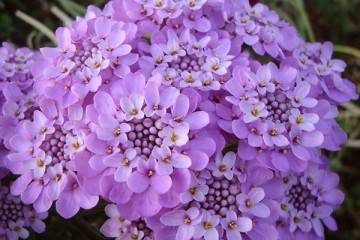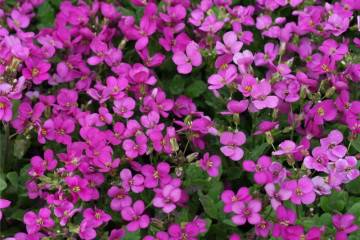Perennial small petals or Erigeron - planting and care
Content:
The perennial small-petal belongs to the Astrov family. Its scientific name comes from the Latin Erigeron. The birthplace of the flower is North America. An unpretentious plant for several centuries has found wide distribution in Europe. Decorates curbs, flower beds, looks great in any corner of the park, summer cottage. There are more than 200 species. This is mainly a perennial, but there are also annual varieties.
Description of the plant
Small petals, the descriptions of which are so different, have common characteristics. The height of the bushes is usually 15 to 60 centimeters. In the upper part, they are dotted with small bright flowers of various colors: white, pink, purple, orange, blue, lilac. Some varieties begin to bloom in summer and continue to delight with a beautiful appearance until autumn frosts.
The erigeron flower has a yellow tubular center, along the edge of several rows of small, brightly colored, fluffy reed petals. They gave the name to the plant - small petals. The diameter of the peduncles is from 2 to 5 centimeters.
Types of erigeron
Plants look very diverse, depending on the variety:
- The annual small petal (erigeron Annuus) has white peduncles. The height of the branches ranges from 30 centimeters or more.
- Orange (erigeron Aurantiacus) blooms from early July. The bush grows up to 50 centimeters in diameter.
- Small-petal Beautiful (erigeron Speciosus) - the most common in our flower beds, the color of flowers can vary from pink to red and lilac, from blue to dark blue.
- Alpine - low, the stems are even, straight, the flowers are white or light purple.
- Small-petaled Inozemny has pink-lilac flowers that abundantly adorn its even tall stem.
- Compositae (erigeron Compositus Pursh) can withstand a sharply continental climate, grows on loose rocks.
- Soddy has one or more pale white or purple inflorescences on low stems.
- Small-petal Karvinsky (erigeron Karvinskianus) is a compact bush that looks good both on flower beds and in hanging compositions, its flowers are like small daisies.
- Erigeron Glaucus is often called the coastal aster, the plant is short, in the lower part there are long basal leaves, purple or lilac baskets on the stems.
- Erigeron Trifidus has leaves mainly in the root rosette, blooms all summer.
- Small-petaled Miyabe - leaves are fluffy, ovoid, resembling a lotus, in flowers with a diameter of 3.5 centimeters, the marginal blue petals are arranged in one row.
Popular new varieties
Small petal or erigeron is a plant that is widespread in the wild. It has long been successfully cultivated by professional flower growers.
New varieties are constantly appearing:
- Pink treasure. A very bright and beautiful variety, reaching a height of 65 centimeters. Beautiful pink buds are collected in basket inflorescences. It blooms profusely twice - at the beginning and at the end of summer. The most optimal way to get seedlings of the Erigeron Pink Treasure variety is to grow from seeds.
- Erigeron Foster Laibling has double, with a yellow center, large, rich pink flowers, collected in openwork inflorescences. Powerful stems make up a continuous bright bedspread.
- Small-leafed Marguerite-leaved spreads in a low dense carpet. Small white flowers resemble daisies.
- Erigeron Azur Beauty is a winter-hardy small petal, grows in the sun and in the shade. The lavender shade of flowers will accentuate the beauty of a flower bed or landscape design.
- Small-petal Rose of July is winter-hardy, very decorative, not too whimsical to care for. A beautiful pink basket along the edge may consist of one or three rows of reed petals.
Various varieties will allow you to decorate the flower garden in a new way.
Growing a plant
Florists, professionals and amateurs appreciate the flower for its positive properties: unpretentious care, many ways of reproduction.
The root system of the flower branches well during the growing season. In the spring, it is convenient to separate part of the bush and plant it in the chosen place. Erigeron, planting and caring for which in the open field is not too difficult, will bloom in the same year.
How to propagate
New varieties can be propagated by seed. They are sown shallowly into loosened soil in late autumn or early spring. Before planting, the ground is watered with warm water. The seeds are slightly deepened. From above, you can cover the site with mulch or stretch the film to form a small greenhouse.
For the northern regions, it is advisable to grow seedlings in a greenhouse. You can also plant seeds in cups in a heated room, and then transfer the finished seedlings into the ground in June.
You can also separate the stalk with part of the root from the main bush and keep it in a greenhouse for three weeks, and then plant it in prepared soil.
Choosing a landing site
For landing, you should choose the best place. The flower feels good in sunlit areas, is not afraid of drafts. Too shaded areas are a contraindication. Here the plant is unlikely to grow, and you can forget about its flowering.
After five years, the bushes must be divided and transplanted to a new location. It is beneficial for plant rejuvenation.
Watering
You should not overmoisten the soil too much, but you need to monitor watering, since the land should not be overdried.
Top dressing
Top dressing is optional. Although during the flowering period, the use of mineral fertilizers with potassium and phosphorus will help the formation of more buds.
Preparing for winter
In late autumn, the stems should be cut short and the bushes should be insulated with fallen leaves. This is especially necessary if there are severe frosts in this place in winter.
Plant diseases and pests
The flower is unpretentious, but afraid of dampness. In rainy summers, its leaves and stems can infect mold and fungal diseases. In this case, the plant must be sprinkled with ash or, with a period of 10 days, treated several times with a Bordeaux mixture.
The small petal feels great on the alpine slides. Several species can be used to make a continuous multi-colored lawn. Tall bushes sometimes need a garter to keep the stems from falling to the ground.
Erigeron, planting and caring for which does not require significant effort, is well suited for flower beds and borders in summer cottages, where the owners appear only occasionally. The rules for growing and caring for it are simple, and the decorative qualities are excellent.
